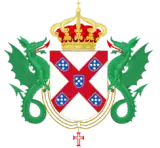Isabel of Barcelos
Isabel of Barcelos (October 1402 – 26 October 1466), also known as Isabel of Braganza, was a lady of the Portuguese nobility during the Late Middle Ages. She was the daughter of Afonso I, Duke of Braganza and Beatriz Pereira de Alvim, and she married Infante John, Lord of Reguengos de Monsaraz, her half-uncle, son of John I of Portugal.
| Isabel | |
|---|---|
| Lady of Reguengos de Monsaraz, Colares and Belas | |
_-_Genealogia_de_D._Manuel_Pereira%252C_3.%C2%BA_conde_da_Feira_(1534).png.webp) Isabel in a 1534 miniature in the Genealogy of D. Manuel Pereira, 3rd Count of Feira | |
| Born | October 1402 Barcelos |
| Died | 26 October 1466 (aged 63–64) Arévalo |
| Burial | |
| Spouse | John, Constable of Portugal |
| House | House of Braganza |
| Father | Afonso I, Duke of Braganza |
| Mother | Beatriz Pereira de Alvim |
| Religion | Roman Catholicism |
Issue
Isabel and Infante John had four children:
- Infante Diogo of Portugal (1425–1443) – 4th Constable of Portugal and 11th Master of the Order of St. James;
- Infanta Isabella of Portugal (1428–1496), married John II of Castile, mother of Isabella I of Spain
- Infanta Beatrice of Portugal (1430–1506), married Infante Ferdinand, Duke of Viseu, mother of Manuel I of Portugal
- Infanta Phillipa of Portugal (1432–1444), Lady of Almada
Isabel died in the town of Arévalo on 26 October 1466 at the age of sixty-four. She was buried in the Batalha Monastery alongside her husband.
Ancestry
| Ancestors of Isabel of Barcelos[1] | |||||||||||||||||||||||||||||||||||||||||||||||||||||||||||||||||||||||||||||||||||||||||||||||||||||||||||||||||||||||||||||||||||||||||||||||||||||||||||||||||||||||||||||||||||||||||||||||||||||||||||||||||||||||||||||||||||||||||||||||||||||||||||||||||||||||||||||||||||||||||
|---|---|---|---|---|---|---|---|---|---|---|---|---|---|---|---|---|---|---|---|---|---|---|---|---|---|---|---|---|---|---|---|---|---|---|---|---|---|---|---|---|---|---|---|---|---|---|---|---|---|---|---|---|---|---|---|---|---|---|---|---|---|---|---|---|---|---|---|---|---|---|---|---|---|---|---|---|---|---|---|---|---|---|---|---|---|---|---|---|---|---|---|---|---|---|---|---|---|---|---|---|---|---|---|---|---|---|---|---|---|---|---|---|---|---|---|---|---|---|---|---|---|---|---|---|---|---|---|---|---|---|---|---|---|---|---|---|---|---|---|---|---|---|---|---|---|---|---|---|---|---|---|---|---|---|---|---|---|---|---|---|---|---|---|---|---|---|---|---|---|---|---|---|---|---|---|---|---|---|---|---|---|---|---|---|---|---|---|---|---|---|---|---|---|---|---|---|---|---|---|---|---|---|---|---|---|---|---|---|---|---|---|---|---|---|---|---|---|---|---|---|---|---|---|---|---|---|---|---|---|---|---|---|---|---|---|---|---|---|---|---|---|---|---|---|---|---|---|---|---|---|---|---|---|---|---|---|---|---|---|---|---|---|---|---|---|---|---|---|---|---|---|---|---|---|---|---|---|---|---|---|---|
| |||||||||||||||||||||||||||||||||||||||||||||||||||||||||||||||||||||||||||||||||||||||||||||||||||||||||||||||||||||||||||||||||||||||||||||||||||||||||||||||||||||||||||||||||||||||||||||||||||||||||||||||||||||||||||||||||||||||||||||||||||||||||||||||||||||||||||||||||||||||||
References
- de Sousa, Antonio Caetano (1735). Historia genealogica da casa real portugueza [Genealogical History of the Royal House of Portugal] (in Portuguese). 2. Lisboa Occidental. p. 167.
This article is issued from Wikipedia. The text is licensed under Creative Commons - Attribution - Sharealike. Additional terms may apply for the media files.
